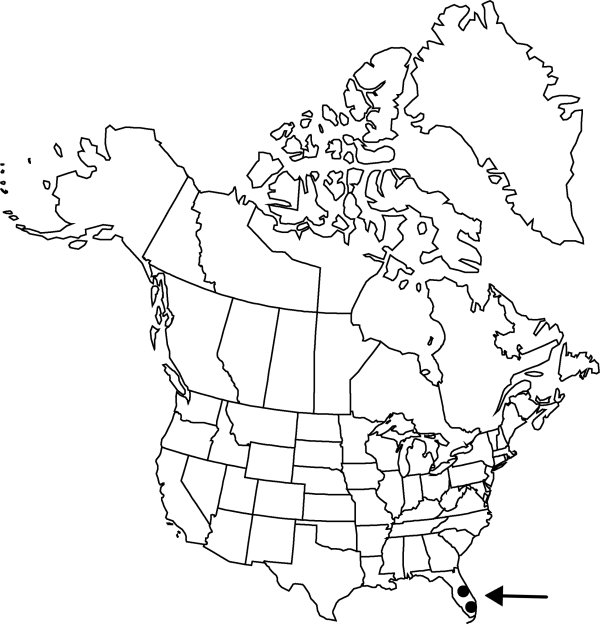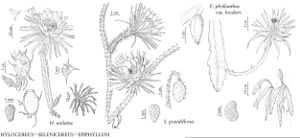Difference between revisions of "Selenicereus grandiflorus"
Contr. U.S. Natl. Herb. 12: 430. 1909.
FNA>Volume Importer |
imported>Volume Importer |
||
| (2 intermediate revisions by 2 users not shown) | |||
| Line 8: | Line 8: | ||
}} | }} | ||
|common_names=Queen- of-the-night;reina de la noche | |common_names=Queen- of-the-night;reina de la noche | ||
| + | |special_status={{Treatment/ID/Special_status | ||
| + | |code=I | ||
| + | |label=Introduced | ||
| + | }}{{Treatment/ID/Special_status | ||
| + | |code=F | ||
| + | |label=Illustrated | ||
| + | }} | ||
|basionyms={{Treatment/ID/Basionym | |basionyms={{Treatment/ID/Basionym | ||
|name=Cactus grandiflorus | |name=Cactus grandiflorus | ||
| Line 38: | Line 45: | ||
|elevation=0-5 m | |elevation=0-5 m | ||
|distribution=Fla.;Mexico;West Indies. | |distribution=Fla.;Mexico;West Indies. | ||
| + | |introduced=true | ||
|discussion=<p><i>Selenicereus grandiflorus</i> is one of several species from diverse genera known by the common name queen-of-the-night. It is widely grown for its large, showy flowers and has escaped from cultivation in many areas. The species has been reported from Broward and St. Lucie counties, Florida, where it appears to be naturalized.</p><!-- | |discussion=<p><i>Selenicereus grandiflorus</i> is one of several species from diverse genera known by the common name queen-of-the-night. It is widely grown for its large, showy flowers and has escaped from cultivation in many areas. The species has been reported from Broward and St. Lucie counties, Florida, where it appears to be naturalized.</p><!-- | ||
--><p><i>Selenicereus grandiflorus</i> has been used in the preparation of a heart tonic similar to digitalis (E. F. Anderson 2001).</p><!-- | --><p><i>Selenicereus grandiflorus</i> has been used in the preparation of a heart tonic similar to digitalis (E. F. Anderson 2001).</p><!-- | ||
| Line 63: | Line 71: | ||
|publication title=Contr. U.S. Natl. Herb. | |publication title=Contr. U.S. Natl. Herb. | ||
|publication year=1909 | |publication year=1909 | ||
| − | |special status= | + | |special status=Introduced;Illustrated |
| − | |source xml=https:// | + | |source xml=https://bitbucket.org/aafc-mbb/fna-data-curation/src/2e0870ddd59836b60bcf96646a41e87ea5a5943a/coarse_grained_fna_xml/V4/V4_337.xml |
|subfamily=Cactaceae subfam. Cactoideae | |subfamily=Cactaceae subfam. Cactoideae | ||
|genus=Selenicereus | |genus=Selenicereus | ||
Latest revision as of 21:57, 5 November 2020
Plants usually terrestrial and hemi-epiphytic, sometimes epiphytic, clambering or vinelike. Roots terrestrial and adventitous. Stems green to bluish green, becoming purplish along ribs, to several m, 1–2.5 cm diam.; ribs 5–8, low; areoles usually 1–2 cm apart along ribs, 1–2 mm diam. Spines eventually deciduous, 6–18 per areole, whitish to brownish, ± bristlelike or short acicular, 4.5–12(–15) mm, intermixed with long, whitish hairs; radial and central spines not distinguishable. Flowers 17.5–30 × 12.5–17.5 cm; outer tepals brown, orange, or lemon yellow, linear; inner tepals white, oblanceolate, apex acute; areoles of ovary and flower tube bearing long hairlike spines. Fruits pink to whitish, ovoid, 50–90 × 45–70 mm, covered with numerous hairlike spines. 2n = 22.
Phenology: Flowering year-round.
Habitat: Disturbed coastal sites
Elevation: 0-5 m
Distribution

Introduced; Fla., Mexico, West Indies.
Discussion
Selenicereus grandiflorus is one of several species from diverse genera known by the common name queen-of-the-night. It is widely grown for its large, showy flowers and has escaped from cultivation in many areas. The species has been reported from Broward and St. Lucie counties, Florida, where it appears to be naturalized.
Selenicereus grandiflorus has been used in the preparation of a heart tonic similar to digitalis (E. F. Anderson 2001).
D. R. Hunt (1989) discussed problems with the typification of Selenicereus grandiflorus and suggested that the dozen or more species in section Selenicereus probably represent no more than three or four species, e.g., S. grandiflorus, S. pteranthus (Link & Otto) Britton & Rose, and S. hamatus (Scheidweiler) Britton & Rose. Myron Kimnach (pers. comm.) suggested that S. coniflorus should be treated under S. grandiflorus, either as a synonym or as a variety. As Hunt noted, this suite of taxa is in need of substantial work. Pending such investigation, it seems best not to recognize varieties of S. grandiflorus.
Selected References
None.
